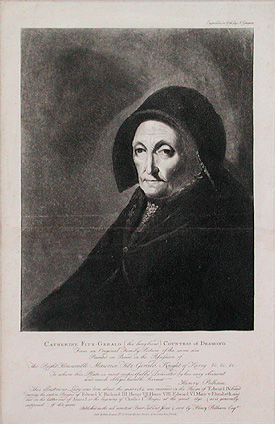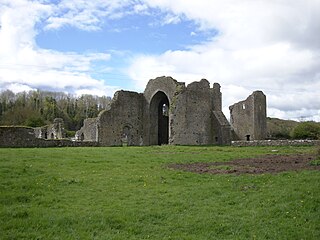
Earl of Desmond is a title of nobility created by the English monarch in the peerage of Ireland. The title has been created four times. It was first awarded in 1329 to Maurice FitzGerald, 4th Baron Desmond, a Hiberno-Norman lord in Southwest Ireland, and it was held by his descendants until 1583 when they rose against the English crown in the Desmond Rebellions. Following two short-lived recreations of the title in the early 1600s, the title has been held since 1628 by the Feilding family of Warwickshire, England. The current holder is Alexander Feilding, 12th Earl of Denbigh and 11th Earl of Desmond.

Sligo Abbey was a Dominican convent in Sligo, Ireland, founded in 1253. It was built in the Romanesque style with some later additions and alterations. Extensive ruins remain, mainly of the church and the cloister.

Adare is a village in County Limerick, Ireland, located southwest of the city of Limerick. Adare is designated as a heritage town by the Irish government. The village is in a townland and civil parish of the same name.

Katherine FitzGerald, Countess of Desmond was a noblewoman of the Anglo-Norman FitzGerald dynasty in Ireland. English writers of the Tudor period, including Sir Walter Raleigh, helped popularise "the old Countess of Desmond" as a nickname for her, due to her longevity. One estimate placed her age at death in excess of 120 years. Another ranged as high as 140. Most likely she lived to about 100. A recent biography of the countess suggested that Katherine was at least 90 when she died.

Ballybeg Priory, also known as Ballybeg Abbey, the Abbey of St Thomas, and St Thomas's Priory, is a 13th-century priory of the Augustinian order near the town of Buttevant, County Cork, Ireland. It is home to one of the best preserved and most substantial dovecots in Ireland. The priory was founded in 1229 and dissolved in 1541, the land and buildings passing into private hands. Those parts of the buildings that have escaped from the stone being removed for use in other buildings are mostly late medieval.
Events from the year 1224 in Ireland.
Events from the year 1536 in Ireland.
Events from the year 1537 in Ireland.

The South Abbey was a Franciscan friary in Youghal, Ireland active between the 13th and 17th centuries.

Molana Abbey is a 6th-century Abbey located on the south coast of Ireland in the Diocese of Waterford and Lismore, near Youghal. The abbey lies on an island in the River Blackwater. The monks of the monastery helped co-edit Collectio canonum Hibernensis in the 8th century. It came under the control of the Augustinian canons in the 12th century before being seized by the English Crown during the Reformation and gradually falling into ruin.
Maurice Fitzmaurice FitzGerald I, 2nd Lord of Offaly was an Anglo-Norman peer, soldier, and Justiciar of Ireland from 1232 to 1245. He mustered many armies against the Irish, and due to his harsh methods as Justiciar, he received criticism from King Henry III of England. He was succeeded as Lord of Offaly by his son, Maurice FitzGerald, 3rd Lord of Offaly.

James FitzGerald, 6th Earl of Desmond, called 'the Usurper', was a younger son of Gerald FitzGerald, 3rd Earl of Desmond, and Lady Eleanor, daughter of James Butler, 2nd Earl of Ormond.

James fitz John FitzGerald, 13th Earl of Desmond, also counted as the 14th, ruled 22 years, the first 4 years as de facto earl until the death of James FitzGerald, de jure 12th Earl of Desmond, called Court Page, who was murdered by James fitz John's brother Maurice fitz John FitzGerald, called Totane. James fitz John FitzGerald maintained himself in power by skilful diplomacy, avoiding armed conflict and destruction. He was appointed Lord Treasurer of Ireland in 1547.

Thomas Fitzmaurice FitzGerald, 2nd Baron of Desmond, was the son of Maurice FitzJohn FitzGerald and grandson of John FitzThomas FitzGerald from whom he inherited the title.

James fitz Maurice FitzGerald, 10th Earl of Desmond, also counted as the 11th, plotted against King Henry VIII with King Francis I of France in 1523 and with Emperor Charles V in 1528 and 1529.

Askeaton Abbey or Askeaton Friary is a ruined medieval Franciscan friary located north of Askeaton, County Limerick, Ireland, on the east bank of the River Deel.
The sack of Youghal was the capture of the English-held town of Youghal by Irish rebel forces under the command of the Gerald FitzGerald, the 14th Earl of Desmond on 13 November 1579 as part of the Second Desmond Rebellion. Youghal, a town in the Irish province of Munster, was controlled by the English, making it a target to Irish rebel forces during the rebellion. FitzGerald led an Irish rebel force which captured the city, massacred the English Army garrison, and sacked the town. After news of the sack became known, numerous reprisals were carried out on Catholic non-combatants throughout Ireland.

Cormac Oge Laidir MacCarthy, 10th Lord of Muskerry (1447–1536) was an Irish chieftain, styled Lord of Muskerry. In 1520 he defeated James FitzGerald, 10th Earl of Desmond in the battle of Mourne Abbey.















